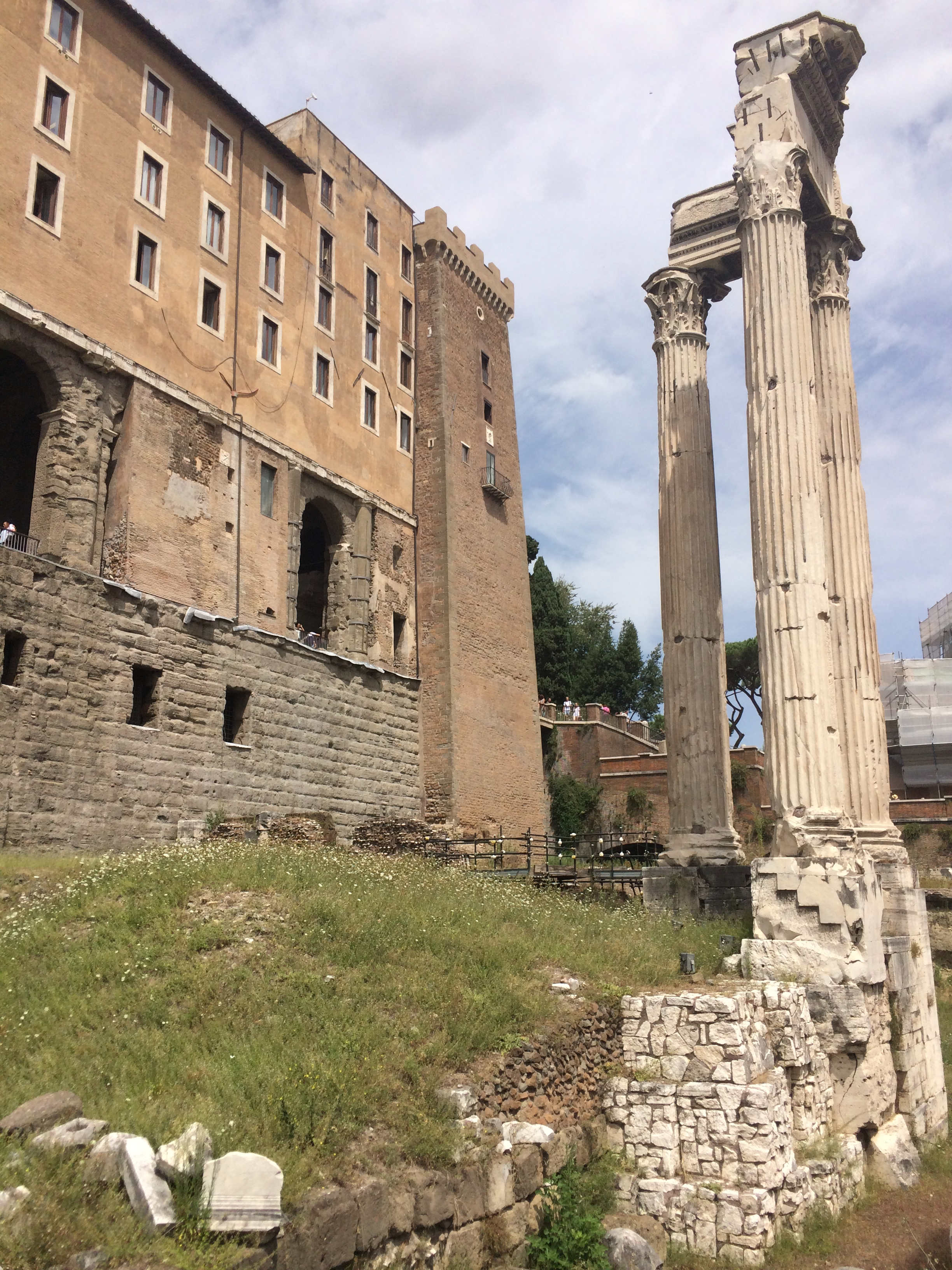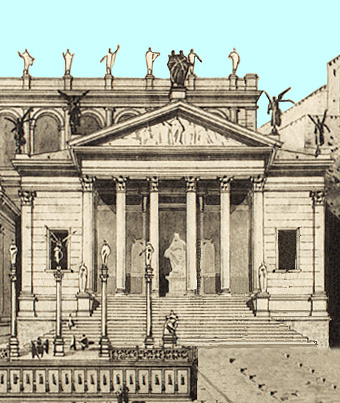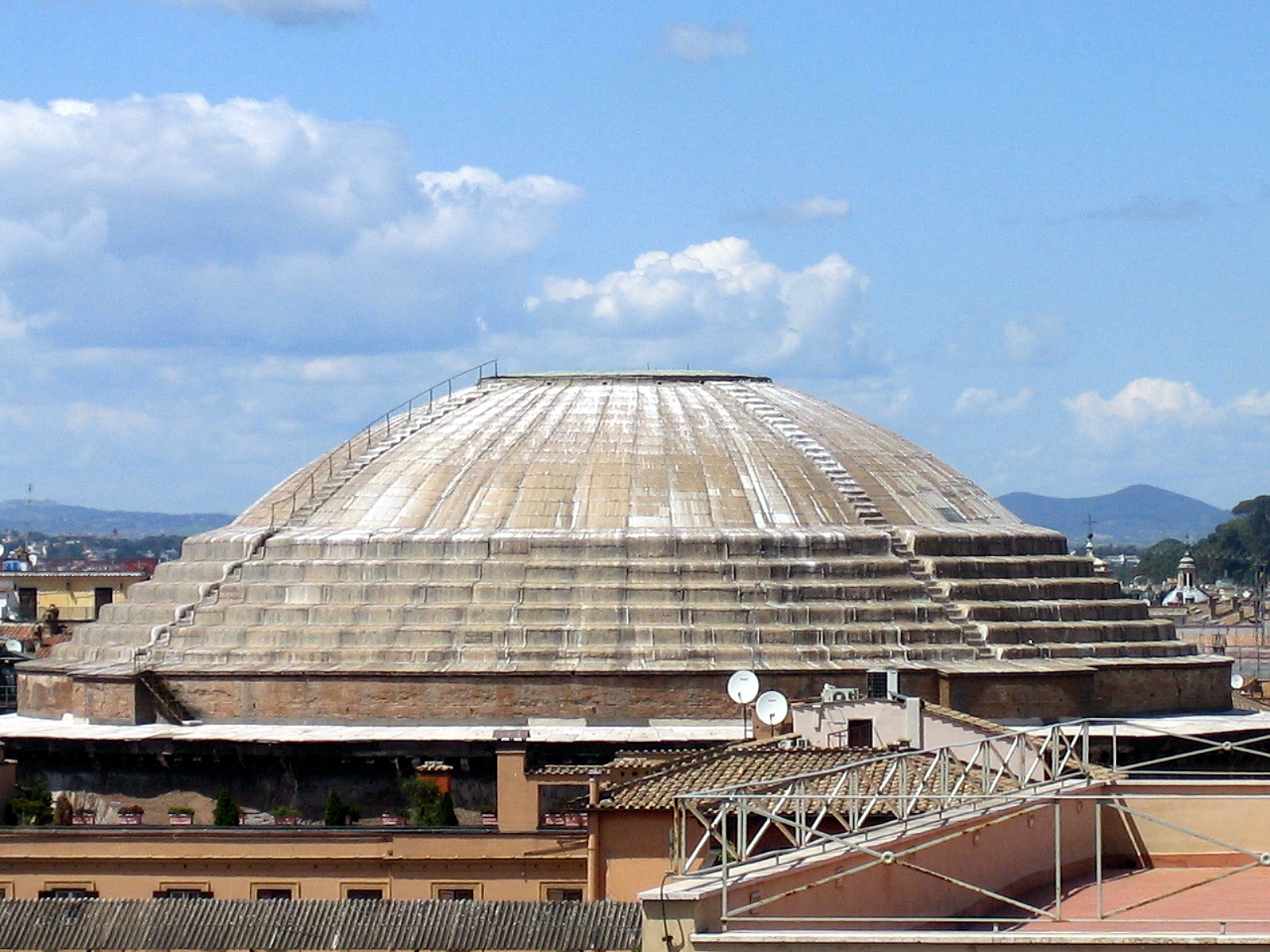|
Tabularium
The Tabularium was the official records office of ancient Rome and housed the offices of many city officials. Situated within the Roman Forum, it was on the front slope of the Capitoline Hill, below the Temple of Jupiter Optimus Maximus, to the southeast of the Arx. Within the building were the remains of the temple of Veiovis. In front of it were the Temples of Vespasian and Concord, as well as the Rostra and the rest of the forum. Presently the Tabularium is only accessible from within the Capitoline Museum, although it still provides a panoramic view over the Forum. The construction of the Tabularium was ordered around 78 BC by the dictator Lucius Cornelius Sulla. The building was completed by Quintus Lutatius Catulus, consul in 78 BC. This was part of a public works programme for the redevelopment of the Capitoline Hill, which had been damaged by a fire in 83 BC. The construction by Catulus is not mentioned in the ancient literature. It is known through an inscription (CIL ... [...More Info...] [...Related Items...] OR: [Wikipedia] [Google] [Baidu] |
Capitoline Hill
The Capitolium or Capitoline Hill ( ; it, Campidoglio ; la, Mons Capitolinus ), between the Forum and the Campus Martius, is one of the Seven Hills of Rome. The hill was earlier known as ''Mons Saturnius'', dedicated to the god Saturn. The word ''Capitolium'' first meant the temple of Jupiter Optimus Maximus later built here, and afterwards it was used for the whole hill (and even other temples of Jupiter on other hills), thus ''Mons Capitolinus'' (the adjective noun of ''Capitolium''). In an etymological myth, ancient sources connect the name to ''caput'' ("head", "summit") and the tale was that, when laying the foundations for the temple, the head of a man was found, some sources even saying it was the head of some ''Tolus'' or ''Olus''. The ''Capitolium'' was regarded by the Romans as indestructible, and was adopted as a symbol of eternity. By the 16th century, ''Capitolinus'' had become ''Capitolino'' in Italian, and ''Capitolium'' ''Campidoglio''. The Capitoline Hill ... [...More Info...] [...Related Items...] OR: [Wikipedia] [Google] [Baidu] |
Temple Of Veiovis
The Temple of Veiovis in ancient Rome was the temple of the god Veiovis. In literature The temple was sited in the saddle of ground "inter duos lucos", between two sacred groves, one on the Arx and one on the Capitolium (the two peaks of the Capitoline Hill). The statue of the god stood next to a statue of a goat. In the same area was also situated the Asylum, where, legend has it, Romulus extended hospitality to fugitives from other parts of the Latium region, in order to populate the new city which he founded, with political refugees, escaped slaves, Latins and Etruscans, and, as Florus has it, Phrygians and Arcadians. Florus, I.9, noted by Emma Dench, ''Romulus' asylum: Roman identities from the age of Alexander to the age of Hadrian'' (Oxford University Press) 2005, p. 2 note 4. Its construction was vowed in 200 BC by the praetor Lucius Furius Purpurio in the Battle of Cremona during the war against the Boii, and then dedicated in 192 BC by Quintus Marcius Ralla. In arc ... [...More Info...] [...Related Items...] OR: [Wikipedia] [Google] [Baidu] |
Circus Maximus
The Circus Maximus (Latin for "largest circus"; Italian: ''Circo Massimo'') is an ancient Roman chariot-racing stadium and mass entertainment venue in Rome, Italy. In the valley between the Aventine and Palatine hills, it was the first and largest stadium in ancient Rome and its later Empire. It measured in length and in width and could accommodate over 150,000 spectators. In its fully developed form, it became the model for circuses throughout the Roman Empire. The site is now a public park. Events and uses The Circus was Rome's largest venue for ''ludi'', public games connected to Roman religious festivals. ''Ludi'' were sponsored by leading Romans or the Roman state for the benefit of the Roman people (''populus Romanus'') and gods. Most were held annually or at annual intervals on the Roman calendar. Others might be given to fulfil a religious vow, such as the games in celebration of a triumph. In Roman tradition, the earliest triumphal ''ludi'' at the Circus were ... [...More Info...] [...Related Items...] OR: [Wikipedia] [Google] [Baidu] |
Temple Of Vespasian And Titus
The Temple of Vespasian and Titus ( la, Templum divi Vespasiani,Platner, Samuel B., and Ashby, Thomas. ''A Topographical Dictionary of Ancient Rome''. London: Oxford UP, 1929; p. 556. it, Tempio di Vespasiano) is located in Rome at the western end of the Roman Forum between the Temple of Concordia and the Temple of Saturn. It is dedicated to the deified Vespasian and his son, the deified Titus. It was begun by Titus in 79 after Vespasian's death and Titus's succession. Titus’ brother, Domitian, completed and dedicated the temple to Titus and Vespasian in approximately 87. Importance Throughout Roman history, there was an emphasis on increasing the fame and glory of a family name, often through monuments commemorating the deceased. Therefore, the temple was constructed to honor the Flavian Dynasty, which comprised the emperors Vespasian (69–79), Titus (79–81), and Domitian (81–96). Historians question whether or not Titus and Domitian had a good relationship; howev ... [...More Info...] [...Related Items...] OR: [Wikipedia] [Google] [Baidu] |
Porticus Octaviae
The Porticus Octaviae (Portico of Octavia; it, Portico di Ottavia) is an ancient structure in Rome. The colonnaded walks of the portico enclosed the temples of Jupiter Stator and Juno Regina, as well as a library. The structure was used as a fish market from the medieval period up to the end of 19th century. History The structure was built by Augustus in the name of his sister, Octavia Minor, sometime after 27 BC, in place of the Porticus Metelli. The colonnaded walks of the portico enclosed the temples of Jupiter Stator and Juno Regina, next to the Theater of Marcellus. It burned in 80 AD and was restored, probably by Domitian, and again after a second fire in 203 AD by Septimius Severus and Caracalla. It was adorned with foreign marble and contained many famous works of art, enumerated in Pliny's '' Natural History''. The structure was damaged by an earthquake in 442 AD, when two of the destroyed columns were replaced with an archway which still stands. A church was bui ... [...More Info...] [...Related Items...] OR: [Wikipedia] [Google] [Baidu] |
Roman Forum
The Roman Forum, also known by its Latin name Forum Romanum ( it, Foro Romano), is a rectangular forum (plaza) surrounded by the ruins of several important ancient government buildings at the center of the city of Rome. Citizens of the ancient city referred to this space, originally a marketplace, as the ', or simply the '. For centuries the Forum was the center of day-to-day life in Rome: the site of triumphal processions and elections; the venue for public speeches, criminal trials, and gladiatorial matches; and the nucleus of commercial affairs. Here statues and monuments commemorated the city's great men. The teeming heart of ancient Rome, it has been called the most celebrated meeting place in the world, and in all history. Located in the small valley between the Palatine and Capitoline Hills, the Forum today is a sprawling ruin of architectural fragments and intermittent archaeological excavations attracting 4.5 million or more sightseers yearly. Many of the olde ... [...More Info...] [...Related Items...] OR: [Wikipedia] [Google] [Baidu] |
Regio VIII Forum Romanum
The Regio VIII Forum Romanum Magnum is the eighth regio of imperial Rome, under Augustus's administrative reform. Regio VIII took its name from the Roman Forum, the political centre of Ancient Rome. Geographic extent and important features Regio VIII was the central region of Rome, both geographically and politically. In extent, the region was bordered by the Servian Wall to its northeast and the Palatine Hill to the southeast, while the western outcrop of the Quirinal Hill and the Via Sacra formed its eastern boundaries. It therefore included the Capitoline Hill, the valley between the Palatine and the Capitoline hills (where the Roman Forum is nestled), and the area between Velian Hill and the Palatine just before the point where the Arch of Titus straddles the Via Sacra. A measurement taken at the end of the 4th century recorded that the perimeter of the region was 13,067 Roman feet (approximately 3.86 km). The region was dominated by the massive sanctuary of Rome that ... [...More Info...] [...Related Items...] OR: [Wikipedia] [Google] [Baidu] |
Temple Of Concord
The Temple of Concord ( la, Aedes Concordiae) in the ancient city of Rome refers to a series of shrines or temples dedicated to the Roman goddess Concordia, and erected at the western end of the Roman Forum. The earliest temple is believed to have been vowed by Marcus Furius Camillus in 367 BC, but it may not have been built until 218 BC by L. Manlius. The temple was rebuilt in 121 BC, and again by the future emperor Tiberius between 7 BC and AD 10. History One tradition ascribes the first Temple of Concord to a vow made by Camillus in 367 BC, on the occasion of the ''Lex Licinia Sextia'', the law passed by the tribunes Gaius Licinius Stolo and Lucius Sextius Lateranus, opening the consulship to the plebeians. The two had prevented the election of any magistrates for a period of several years, as part of the conflict of the orders. Nominated dictator to face an invasion of the Gauls, Camillus, encouraged by his fellow patrician Marcus Fabius Ambustus, Stolo's father-i ... [...More Info...] [...Related Items...] OR: [Wikipedia] [Google] [Baidu] |
List Of Roman Domes
This is a list of Roman domes. The Romans were the first builders in the history of architecture to realize the potential of domes for the creation of large and well-defined interior spaces. Domes were introduced in a number of Roman building types such as temples, thermae, palaces, mausolea and later also churches. Semi-domes also became a favoured architectural element and were adopted as apses in Christian church architecture. Monumental domes began to appear in the 1st century BC in Rome and the provinces around the Mediterranean Sea. Along with vaults and trusses, they gradually replaced the traditional post and lintel construction which makes use of the column and architrave. The construction of domes was greatly facilitated by the invention of concrete, a process which has been termed the Roman Architectural Revolution. Their enormous dimensions remained unsurpassed until the introduction of structural steel frames in the late 19th century (see List of largest domes). ... [...More Info...] [...Related Items...] OR: [Wikipedia] [Google] [Baidu] |
Archive
An archive is an accumulation of historical records or materials – in any medium – or the physical facility in which they are located. Archives contain primary source documents that have accumulated over the course of an individual or organization's lifetime, and are kept to show the function of that person or organization. Professional archivists and historians generally understand archives to be records that have been naturally and necessarily generated as a product of regular legal, commercial, administrative, or social activities. They have been metaphorically defined as "the secretions of an organism", and are distinguished from documents that have been consciously written or created to communicate a particular message to posterity. In general, archives consist of records that have been selected for permanent or long-term preservation on grounds of their enduring cultural, historical, or evidentiary value. Archival records are normally unpublished and almost alway ... [...More Info...] [...Related Items...] OR: [Wikipedia] [Google] [Baidu] |
78 BC
__NOTOC__ Year 78 BC was a year of the pre-Julian Roman calendar. At the time it was known as the Year of the Consulship of Lepidus and Catulus. Later and less frequently, it was known as the year 676 AUC). The denomination 78 BC for this year has been used since the early medieval period, when the Anno Domini calendar era became the prevalent method in Europe for naming years. Events By place Roman Republic * In Rome, Marcus Aemilius Lepidus becomes consul. He attempts to undermine the Sullan reforms, quarrels with his consular colleague, is sent to govern Transalpine Gaul, and initiates a rebellion against the Senate with his army there. * The Senate sends Publius Servilius Vatia to Cilicia as governor, where he fights a successful campaign against the Piracy in southern Anatolia (Lycia, Pamphylia and Isauria), he is thereafter known by the agnomen Isauricus. * The Tabularium is built in the Forum. * The Third Dalmatian war begins. Births * Jing Fang, Chinese m ... [...More Info...] [...Related Items...] OR: [Wikipedia] [Google] [Baidu] |
Quintus Lutatius Catulus Capitolinus
Quintus Lutatius Catulus Capitolinus (c. 121 – 61 BC) was a politician in the late Roman Republic. His father was the like-named Quintus Lutatius Catulus, consul in 102 BC. He gained the agnomen "Capitolinus" for his defense of the capital in 77 BC against Lepidus. Biography Catulus inherited his father's hatred of the leading statesman and general Marius, and was a consistent though moderate supporter of the aristocracy. During Sulla's proscription, Catulus avenged the death of his father with the assistance of Catiline, who tortured and killed Marcus Marius Gratidianus at the tomb of the senior Catulus. During Sulla's dictatorship, he was involved in the reconstruction of the Temple of Jupiter Optimus Maximus which had been destroyed by fire in 83, also giving his name to the new temple. In 78 BC, he was consul with Marcus Aemilius Lepidus, who after the death of Sulla proposed the overthrow of his constitution, the re-establishment of the distribution of grain, the recall ... [...More Info...] [...Related Items...] OR: [Wikipedia] [Google] [Baidu] |


.jpg)






